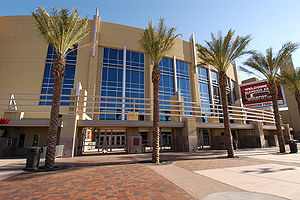Thursday night was an emotional night for fans of the Phoenix Coyotes. NHL hockey in Arizona has been defined by four years of bankruptcy hearings, city council meetings, and popular referendum attempts. But at last the IceArizona group completed their purchase of the franchise from the National Hockey League in August. There are plenty of people who remain skeptical of hockey in Arizona. But ultimately there are many reasons to believe hockey will succeed in the desert.
The History of Hockey in Arizona
Believe it or not, hockey has existed in some form or another in Arizona for quite a long time. In fact, the first attempt at establishing a franchise in Arizona occurred in 1967, when the old Western Hockey League (WHL) minor league moved a team from Victoria, BC to Phoenix. This team was called the Phoenix Roadrunners. It would join the World Hockey Association in 1974. The team would not last long however, as financial problems associated with the WHA caused the Roadrunners to fold after the 1976-77 season.
Professional hockey in Arizona would take a roughly 10 year hiatus until the Roadrunners were revived as part of the International Hockey League (IHL) in 1989. This incarnation of the Roadrunners would survive until 1997, primarily because Arizona sports mogul Jerry Coleangelo succeeded in bringing the Winnipeg Jets to Phoenix in 1996. Since then, the Coyotes have had a rocky history, with both success and failure at different times in their 18 seasons in the Valley.
Why Hockey Will Succeed in Arizona
So hockey in Arizona actually has a much longer pedigree than is commonly known. And while its true that the Roadrunners never captured the hearts of Valley sports fans in the way that teams like the Phoenix Suns did, there are many important developments that will help make ice hockey an integral part of the Valley’s sports scene.
The Canadian Invasion

While many like to scoff at the scores of Canadian fans who descend on Jobing.com Arena when the Habs, Oilers, or Canucks make their way to town, the truth is IceArizona could not be happier to see them. In recent years, Canadians have made up a substantial portion of home sales in the Greater Phoenix Metropolitan Area, primarily as winter homes. That’s good for Coyotes hockey, as the winter months coincide with the NHL season. If seeing the Habs or the Maple Leafs once a year is not sufficient to satisfy a Canadian’s hockey fix, having an NHL franchise in the Valley is a great way to take advantage of hockey’s rabid popularity north of the border. From a business standpoint, a ticket sold to a Flames fan is the same as a ticket sold to a Coyotes fan, so the more Canadians come to games, the better.
Here to Stay
“Here to Stay” was the original marketing slogan the IceArizona group used upon completion of the Coyotes sale. And while the marketing strategy has since changed, the approach hasn’t. In a recent interview with Yahoo! Sports’ Nick Cotsonika, the ownership group sought to demonstrate that they are in fact staying in the desert. One particular passage is extremely important.
They’re about to announce 12- and 15-year contracts for food and beverage and local television. Though they won’t provide hard numbers and it depends on how conservatively they forecasted, Gosbee said before the puck even dropped they had beaten their economic projection for their first season.
Much has been made about the five year out-clause that exists in the arena management contract between the ownership group and the City of Glendale for use of Jobing.com Arena. To some, it’s a clear indication that the group is planning on cutting and running for greener pastures as soon as possible, and that the relocation of the franchise has only been delayed, not stopped. But the vending and TV contract lengths suggest otherwise. It makes zero economic sense to broker a 15 year contract for broadcasting rights if the team isn’t planning on remaining past Year 5. So the long-term vision of the IceArizona group suggests a legitimate effort to make hockey in Arizona work.
Youth Enrollment
Last year, USA Hockey released its annual youth enrollment numbers. Youth hockey in Arizona ranked 5th among all states in the country in percentage increases. Rinks around the Valley are seeing increases in players young and old. The facility in Scottsdale recently added a third rink to cope with rising demand and to host larger national tournaments. Not only are these hockey’s future stars, but they are hockey’s future fans. While their parents may maintain strong affiliations with the teams they grew up on, kids in the Valley will grow up with the Coyotes, and that bodes well for the team’s future.
Not only that, but players from Arizona are getting closer and closer to making their mark in the NHL. The most prominent Arizona native in the league currently is Sean Couturier of the Philadelphia

Flyers. But more Arizonans are on the way. Henrik Samuelsson, a Scottsdale native, was a first round pick of the Coyotes in 2012. He joined Scottsdale native Zac Larraza in the Coyotes prospect system. It will take time, but if the recent influx of Californians into the NHL is any indication, we may only be a few years away from Arizona natives making up a portion of major-junior and college rosters.
Conclusion
Like hockey in other Sunbelt states, it will take time before the sport permanently solidifies itself. Dallas, Tampa Bay, and San Jose all needed on-ice success and generational turnover to generate stability. The Coyotes are capable of producing that success with pieces like Dave Tippett, Don Maloney, and Oliver Ekman-Larsson. Now it will be time to see if the Valley of the Sun is ready to embrace ice hockey as one of its own.